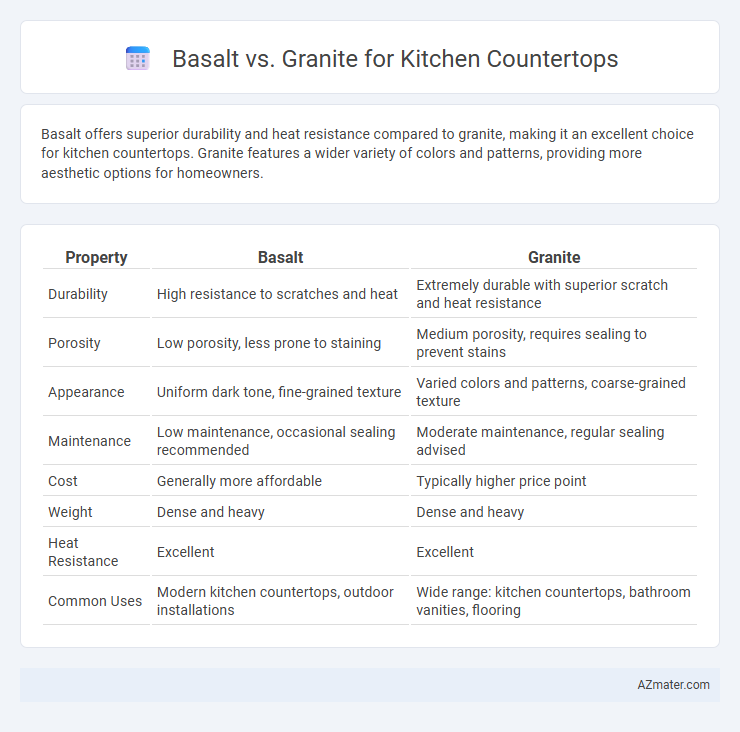Basalt offers superior durability and heat resistance compared to granite, making it an excellent choice for kitchen countertops. Granite features a wider variety of colors and patterns, providing more aesthetic options for homeowners.
Table of Comparison
| Property | Basalt | Granite |
|---|---|---|
| Durability | High resistance to scratches and heat | Extremely durable with superior scratch and heat resistance |
| Porosity | Low porosity, less prone to staining | Medium porosity, requires sealing to prevent stains |
| Appearance | Uniform dark tone, fine-grained texture | Varied colors and patterns, coarse-grained texture |
| Maintenance | Low maintenance, occasional sealing recommended | Moderate maintenance, regular sealing advised |
| Cost | Generally more affordable | Typically higher price point |
| Weight | Dense and heavy | Dense and heavy |
| Heat Resistance | Excellent | Excellent |
| Common Uses | Modern kitchen countertops, outdoor installations | Wide range: kitchen countertops, bathroom vanities, flooring |
Introduction to Basalt and Granite Countertops
Basalt countertops, formed from cooled volcanic lava, offer exceptional durability, natural heat resistance, and a unique dark, matte finish that complements modern kitchen designs. Granite countertops, composed of crystallized magma, provide a wide range of colors and patterns with exceptional hardness and resistance to scratches and stains. Both materials require sealing to maintain their appearance and resilience, making them popular, long-lasting choices for kitchen surfaces.
Geological Origins: Basalt vs Granite
Basalt forms from rapid cooling of low-viscosity lava at the Earth's surface, resulting in a fine-grained volcanic rock with a dense, dark appearance. Granite originates deep within the Earth's crust from slow crystallization of magma, creating a coarse-grained, felsic intrusive igneous rock rich in quartz, feldspar, and mica. The contrasting geological origins influence their texture, durability, and suitability for kitchen countertops, with granite typically offering greater hardness and aesthetic variety.
Physical Appearance and Color Variations
Basalt countertops showcase a fine-grained, uniform texture with deep, rich black or dark gray hues that provide a sleek, modern aesthetic. Granite features a more varied, coarse-grained appearance with a wide spectrum of color variations, including white, pink, red, and green tones, often speckled or veined. The natural patterns in granite offer a dynamic, multi-dimensional look, while basalt's consistent coloration promotes a minimalist and contemporary design.
Durability and Strength Comparison
Basalt and granite both offer exceptional durability for kitchen countertops, with granite being a hard, coarse-grained igneous rock primarily composed of quartz and feldspar, which provides excellent resistance to scratches and heat. Basalt, a fine-grained volcanic rock, is denser and more uniform in composition, making it highly resistant to chipping and cracking under heavy impact. While granite remains slightly more porous than basalt, basalt's higher density contributes to superior strength and longevity in high-use kitchen environments.
Heat and Scratch Resistance
Basalt offers superior heat resistance compared to granite, making it ideal for kitchen countertops exposed to high temperatures from pots and pans. Granite is durable and scratch-resistant but can be more prone to chipping under intense heat stress. Both materials provide excellent scratch resistance, though basalt's dense, fine-grained structure gives it a slight advantage in maintaining a flawless surface over time.
Porosity and Maintenance Requirements
Basalt features lower porosity compared to granite, making it more resistant to stains and less likely to absorb liquids, which simplifies maintenance. Granite's higher porosity demands regular sealing to prevent damage from spills and bacterial growth, increasing upkeep frequency. Both materials are durable, but basalt's tighter grain structure requires less intensive maintenance for long-lasting kitchen countertops.
Cost Differences Between Basalt and Granite
Basalt countertops typically cost between $50 to $120 per square foot, making them generally more affordable than granite, which ranges from $60 to $150 per square foot depending on quality and source. Installation expenses for both materials are similar, but granite's wider variety in color and pattern can affect overall pricing. Budget-conscious homeowners often prefer basalt for its uniform look and lower price point compared to the premium granite options.
Environmental Impact and Sustainability
Basalt, formed from rapidly cooled lava, offers a lower environmental footprint due to its abundant availability and minimal processing compared to granite, which requires extensive quarrying and energy-intensive cutting. The sustainability of basalt is enhanced by its durability and resistance to heat and scratches, reducing the need for replacements and maintenance chemicals. Granite, while natural and durable, involves higher carbon emissions during extraction and transportation, making basalt a more eco-friendly choice for kitchen countertops.
Design Versatility and Aesthetic Appeal
Basalt offers a sleek, modern look with a uniform dark tone that complements minimalist and contemporary kitchen designs, while granite provides a wide range of colors and natural veining that enhances traditional and eclectic aesthetics. Granite's unique patterns create a striking visual impact, making each countertop one-of-a-kind, whereas basalt's subtle texture delivers a consistent and understated elegance. Both materials are durable but differ in design versatility, with granite catering to those seeking varied, vibrant surfaces and basalt appealing to fans of monochromatic, refined styles.
Final Verdict: Choosing the Right Stone for Your Kitchen Countertop
Basalt offers a sleek, modern look with exceptional durability and heat resistance, making it ideal for high-use kitchen countertops. Granite provides a timeless aesthetic with a wide variety of colors and patterns, combined with strong resistance to scratches and stains. The final choice depends on your design preference and maintenance commitment, with basalt favoring a contemporary style and granite supporting classic versatility.

Infographic: Basalt vs Granite for Kitchen Countertop
 azmater.com
azmater.com